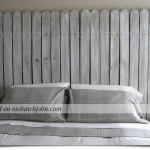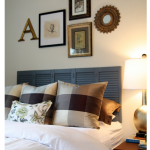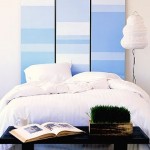 Painting a checkerboard design on a table is a great project that will infuse your front porch (or wherever) with that old-fashioned, laid- back feeling we all associate with a game of checkers. It’s simple, quick and best of all, will probably cost you less than $20 (including the table).
Painting a checkerboard design on a table is a great project that will infuse your front porch (or wherever) with that old-fashioned, laid- back feeling we all associate with a game of checkers. It’s simple, quick and best of all, will probably cost you less than $20 (including the table).
1. Acquire a Table
The first thing you need to do is get your hands on an old end table. Now, maybe you’ve got one stuffed away in your attic or your basement or maybe you’ve got to head to the mission store or start hitting those garage sales. Whatever you need to do, get your hands on an old end table. And don’t worry so much about appearances. This project works well even if the table is chipped, scratched or cracked.
 2. Paint the Table (if necessary)
2. Paint the Table (if necessary)
If the table is not the color you want it to be, follow these instructions to get it looking exactly the way you want it.
3. Pencil in the Checker Board Pattern
If Checkerboardyou’ve got a checker board around the house, get it out and duplicate the pattern on your table using a ruler and light pencil lines. If you don’t have a checker board for reference, a standard checker board is composed of 64 squares laid out on an 8 x 8 board (see inset). 32 will be light and 32 will be dark. We recommend laying the board out with either 2″ squares, 1.5″ squares or 1″ squares based on the size of the table. (Choosing one of these sizes makes it much easier to tape it off later when you get ready to paint).
4. Tape it Off
Once you’ve got the pattern penciled in, it’s time to tackle the most time-consuming part of the project: laying down the masking tape. Start with a roll of safe-release masking tape available at your local home center or hardware store. Purchase the roll in the width that you drew your squares. (If you drew 2″ squares, go with the 2″ tape, etc.) Tape around the edges of the entire board and then tape off alternating lines and alternating squares (see inset).
roll of safe-release masking tape available at your local home center or hardware store. Purchase the roll in the width that you drew your squares. (If you drew 2″ squares, go with the 2″ tape, etc.) Tape around the edges of the entire board and then tape off alternating lines and alternating squares (see inset).
5. tape1Paint the First 16 Squares
Using a paint color darker than the rest of your table (or lighter if you’re table is quite dark), carefully brush or roll the paint over your taped-off table top. As soon as you’ve finished this, carefully remove the tape and let the surface dry. If you’re planning sharp lines for your checker board pattern, then let the table dry overnight. If you’re planning on distressing the top as we have in our photos, you only need to let the top dry for a few minutes. (The reason is this: if you tape over the freshly painted surface too soon, you run the risk of pulling up some of the new paint when you remove your tape. If you’re planning on a distressed look, this doesn’t matter. If not, then you better wait).
6. Tape it Off Again and Paint the Other 16 Squares
After you’ve let the first set of squares dry it’s time to tape off the rest of the board. Lay your tape just as you did the first time, taping off alternating lines and alternating squares (see inset). Once this is accomplished, apply your paint to the open squares using the same method as you did previously. Again, carefully remove the tape immediately after you finish painting.
7. Tape and Paint the Border
Once you’ve finished the squares, lay two strips of tape around each side of the board exposing a 1/8″ or so gap that will become the border. Paint this border in and remove tape carefully.
8. Distress & Finish
If you’re planning on distressing the piece, you can do this as soon as the paint is dry to thChecker Board Table  3e touch, or you can leave this part of the project for another day. Just use light pressure with some 150 grit sandpaper and dust over the entire surface of the table. Continue this until the checker board pattern is sufficiently distressed. Wipe the table clean with a slightly damp rag and, when it’s dry, either leave it as is or apply a single coat of a flat polyurethane varnish or a spray lacquer. (Be advised, unless you use a water-based polyurethane or a non-yellowing lacquer, this protective coat will yellow slightly over time.)
3e touch, or you can leave this part of the project for another day. Just use light pressure with some 150 grit sandpaper and dust over the entire surface of the table. Continue this until the checker board pattern is sufficiently distressed. Wipe the table clean with a slightly damp rag and, when it’s dry, either leave it as is or apply a single coat of a flat polyurethane varnish or a spray lacquer. (Be advised, unless you use a water-based polyurethane or a non-yellowing lacquer, this protective coat will yellow slightly over time.)
This Checkerboard project takes a little bit of patience, but other than that, it’s easy. It’s something anyone can do and it’s extremely inexpensive. Check it out! And let us know how it went!

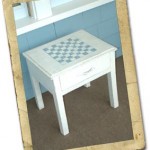
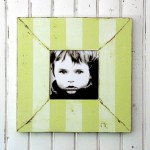
 I found the picture frame at the left when I was cruising around the internet. It was pretty much the type of frame I needed for a particular project I had in mind.
I found the picture frame at the left when I was cruising around the internet. It was pretty much the type of frame I needed for a particular project I had in mind.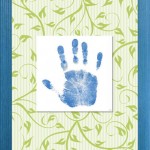

 hed, it’s time to create the handprint in the center. Now, this is not a difficult process, but there are a few things to know that will make your results turn out well. First, you’ve probably seen this done before (at school) where the handprint is “globby” and, well, for lack of a better word…ugly. The reason this happens is because kids usually mash their hands down on the paper while they’re covered with way, way, WAY too much paint.
hed, it’s time to create the handprint in the center. Now, this is not a difficult process, but there are a few things to know that will make your results turn out well. First, you’ve probably seen this done before (at school) where the handprint is “globby” and, well, for lack of a better word…ugly. The reason this happens is because kids usually mash their hands down on the paper while they’re covered with way, way, WAY too much paint.